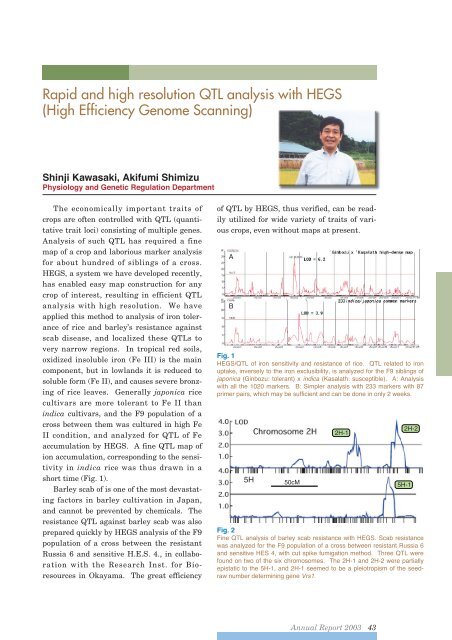Create successful ePaper yourself
Turn your PDF publications into a flip-book with our unique Google optimized e-Paper software.
Rapid and high resolution QTL analysis with HEGS(High Efficiency Genome Scanning)Shinji Kawasaki, Akifumi ShimizuPhysiology and Genetic Regulation DepartmentThe economically important traits ofcrops are often controlled with QTL (quantitativetrait loci) consisting of multiple genes.Analysis of such QTL has required a finemap of a crop and laborious marker analysisfor about hundred of siblings of a cross.HEGS, a system we have developed recently,has enabled easy map construction for anycrop of interest, resulting in efficient QTLanalysis with high resolution. We haveapplied this method to analysis of iron toleranceof rice and barley’s resistance againstscab disease, and localized these QTLs tovery narrow regions. In tropical red soils,oxidized insoluble iron (Fe III) is the maincomponent, but in lowlands it is reduced tosoluble form (Fe II), and causes severe bronzingof rice leaves. Generally japonica ricecultivars are more tolerant to Fe II thanindica cultivars, and the F9 population of across between them was cultured in high FeII condition, and analyzed for QTL of Feaccumulation by HEGS. A fine QTL map ofion accumulation, corresponding to the sensitivityin indica rice was thus drawn in ashort time (Fig. 1).Barley scab of is one of the most devastatingfactors in barley cultivation in Japan,and cannot be prevented by chemicals. Theresistance QTL against barley scab was alsoprepared quickly by HEGS analysis of the F9population of a cross between the resistantRussia 6 and sensitive H.E.S. 4., in collaborationwith the Research Inst. for Bioresourcesin Okayama. The great efficiencyof QTL by HEGS, thus verified, can be readilyutilized for wide variety of traits of variouscrops, even without maps at present.ABFig. 1HEGS/QTL of iron sensitivity and resistance of rice. QTL related to ironuptake, inversely to the iron exclusibility, is analyzed for the F9 siblings ofjaponica (Ginbozu: tolerant) x indica (Kasalath: susceptible). A: Analysiswith all the 1020 markers. B: Simpler analysis with 233 markers with 87primer pairs, which may be sufficient and can be done in only 2 weeks.5H50cM2H-12H-25H-1Fig. 2Fine QTL analysis of barley scab resistance with HEGS. Scab resistancewas analyzed for the F9 population of a cross between resistant Russia 6and sensitive HES 4, with cut spike fumigation method. Three QTL werefound on two of the six chromosomes. The 2H-1 and 2H-2 were partiallyepistatic to the 5H-1, and 2H-1 seemed to be a pleiotropism of the seedrawnumber determining gene Vrs1.<strong>Annual</strong> <strong>Report</strong> <strong>2003</strong> 43













